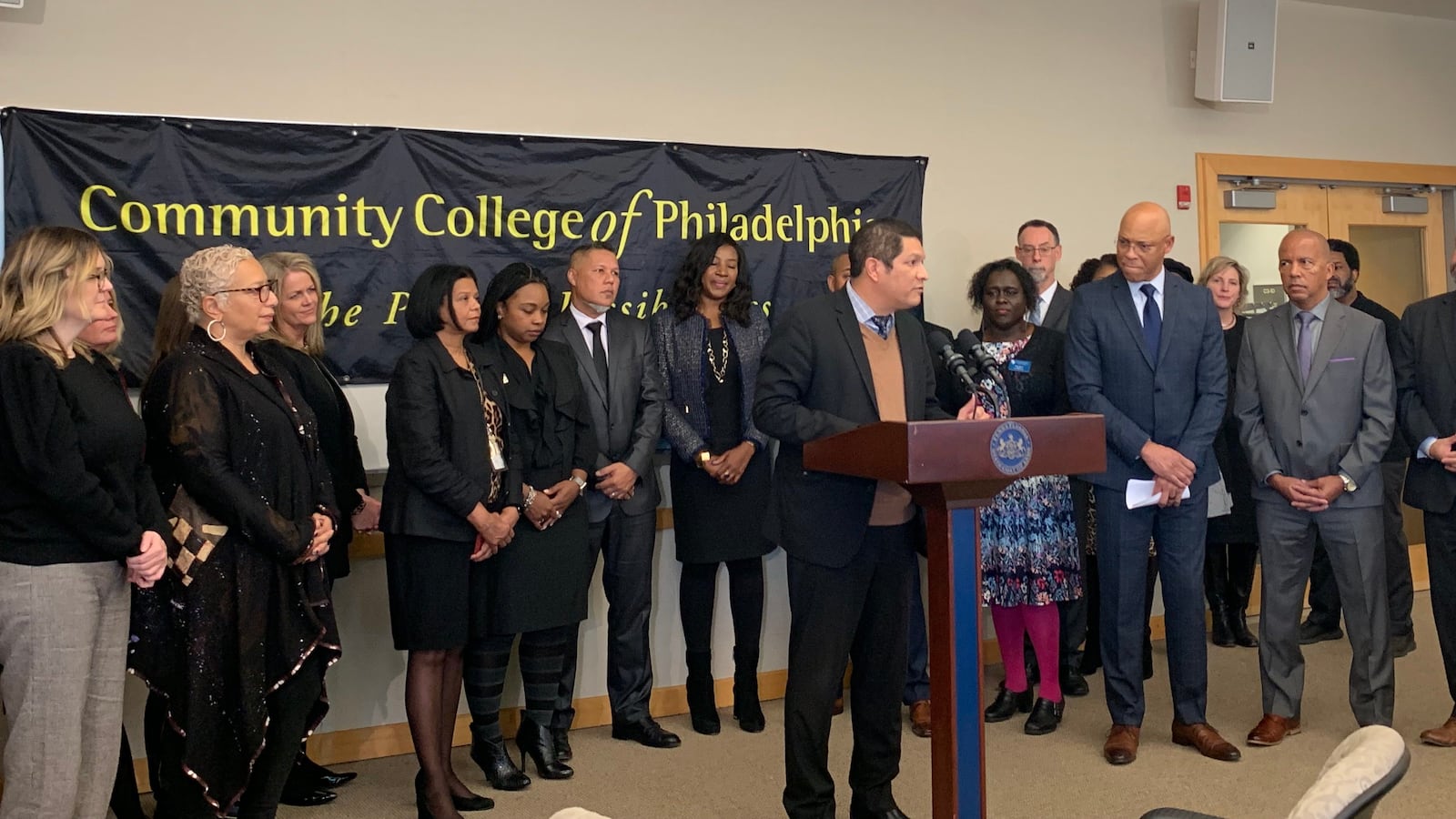This article was originally published in The Notebook. In August 2020, The Notebook became Chalkbeat Philadelphia.
The Pennsylvania Department of Education, along with several college and university partners, is putting new emphasis on recruiting teachers of color by starting a program that seeks to identify potential recruits as early as freshman year in high school and offer them financial help to pursue post-secondary degrees.
The new program, called Aspire to Educate (A2E), will be piloted in the Philadelphia School District.
“We need to strengthen the pipeline for educators, particularly educators of color,” said Donald Generals, president of Community College of Philadelphia (CCP), where the news conference about the program’s launch was held. “I can’t say enough how important this will be for the city of Philadelphia.”
Besides CCP, partners include Drexel, Temple, Arcadia, Cheyney, West Chester, and Cabrini Universities, all in the Philadelphia area. The program hopes to attract not only high school and college students into teaching, but also people with some college who now work in schools and career-changers who have bachelor’s degrees.
Pennsylvania has what Secretary of Education Pedro Rivera described as the “least diverse” teaching force in the country, with just 4% teachers of color, most of whom are concentrated in Philadelphia and Pittsburgh. Plus, between 2013 and 2019, the number of those seeking teaching degrees in Pennsylvania has plummeted by 65%, or 12,000 a year. And the enrollment in teacher preparation programs is also just a fraction of what it was six or seven years ago.
“We have a teacher shortage,” Rivera said. At the same time, “teacher quality is one of the most challenging but one of the most important goals” in improving student achievement,” especially in traditionally underserved communities.
A growing body of research shows that students benefit from having a teacher who looks like them, even if that happens only once or twice in their early school careers.
“When students have teachers who reflect them – in gender, race, ethnicity, cultural life experiences – they do better,” said Sharif El-Mekki, a former Philadelphia teacher and principal who founded the Center for Black Educator Development (CBED). “When students have teachers who reflect the world they want to be a part of, they do better. White students typically have mirrors in front of them leading the classroom, and that reinforces their identity, their goals, their aspirations. Students of color often don’t have these mirrors, they have windows. and quite frequently are marginalized looking at other people and their aspirations.”
El-Mekki said that “increased teacher diversity is better for all students, not just students of color.” His center, founded this year, not only recruits new teachers, but also offers training to all teachers so they can better educate, understand, and respond to students from all backgrounds.
He called A2E “a robust and comprehensive approach” to addressing this issue.
The “youth pathway” seeks to steer high school students into teaching careers. It is partnering with El-Mekki’s organization and the Philadelphia Youth Network, which matches students with summer jobs and internships year-round.
The CBED organizes Freedom Schools each summer, where high school and college students spend several weeks with younger students working on literacy and social action to get a taste of what teaching might be like. Students can also earn college credits toward an education degree while in high school. More than a dozen students from Mastery-Shoemaker, the charter school El-Mekki led for 11 years, are now earning credits through Arcadia University.
Another pathway is for those who have college credits but haven’t earned a degree. Many people in this category already work in schools in other capacities, or they might be still in college but not on an education track.
The program also seeks to attract college graduates who may be ready for a career change. The college and university partners have agreed to provide financial assistance as an incentive to attract people to the program. One deterrent to growing the state’s teaching force has been reduced state appropriations for higher education in general, which have put a growing financial burden on students. Although the higher costs affect all students, those of color and from underserved communities are more likely to drop out of college for financial reasons.
State Deputy Education Secretary Noe Ortega said the goal is to recruit 20 participants in Philadelphia this year. An advisory board will be formed to flesh out and refine the selection process, he said.
Superintendent William Hite said that A2E is “instrumental to us in solving a critical problem we are facing, making sure we have enough teachers of color [who are] qualified to come into our schools and represent the demographics the young people in our schools represent.”
He said that 31% of Philadelphia’s workforce is made up of teachers of color. For the cohort of new hires this year, the percentage is 36%, he said.
“We recognize this is a significant area for growth. … This is what will make a difference for the young people here in the School District of Philadelphia,” he said.
Of the 4% nonwhite teachers in Pennsylvania, most work in Philadelphia, although the District’s proportion of African American teachers has been declining over time and now stands at roughly 25%, down from more than a third in the early 2000s.


